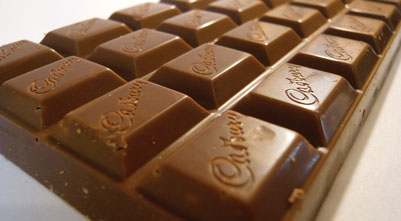Assessing the influence of shape and sound symbolism on the consumer’s response to chocolate
Posted: 1 May 2014 | Charles Spence, Crossmodal Research Laboratory, Oxford University | No comments yet
The new rounded Cadbury’s Dairy Milk chocolate bar has got many consumers agitated because they say it tastes sweeter than the original more rectangular bar. But the company says that the formulation hasn’t changed. Who is right? This furore can perhaps be explained with reference to the literature on shape symbolism. People associate sweetness with roundness and angularity with bitterness, hence making a traditionally rectangular food rounder may alter the perceived taste by priming notions of sweetness in the consumer’s mind. When taken together with the emerging literature on sound symbolic brand naming, it would appear that the confectionary market could learn a trick or two from the psychology lab.


Cadbury Dairy Milk Bar
Shape symbolism in the world of food and beverages
Cadbury’s Dairy Milk chocolate bar hit the headlines in the UK recently1, following complaints the company has been receiving from regular consumers who said that the new, rounder format bar tasted ‘too sweet’ (see Figure 1). Paul Young, an award-winning chocolatier from London commented: “the rectangular chunks of the old bars were integral to the taste of Dairy Milk1.”
Is this, one wonders, just another example of the marketers and focus groups getting it wrong in terms of predicting the response of the consumer when it comes to product innovation? Tony Bilsborough of Mondelez International, the wing of Kraft that runs Cadbury, has stated that: “We have been very clear and consistent that we have not changed the recipe of the much-loved Cadbury Dairy Milk, although it’s certainly true that we changed the chunk last year from the old, angular shape to one that’s curved1.” So what is going on here? I would like to argue that, counterintuitive though it may sound, both the company and the customer may be right.
The mystery of the chocolate bar that has become ‘too sweet’ without its formulation having changed begins to make sense, however, once we start to look into the recent scientific literature on shape symbolism and crossmodal correspondences, as applied to the world of taste and flavour (see3-6 for reviews). For, as far as chocolate is concerned, Gallace and his colleagues2,7 have demonstrated that consumers will normally match the sweeter taste of a milk chocolate with rounder shapes while matching the more bitter taste of dark chocolate with angular shapes instead (see Figure 2). Importantly, this particular finding underlies a more general observation that has now been documented across a range of food and beverage items (and in a number of different studies), namely, that sweetness is associated with roundness while bitterness is associated with angularity instead5-7. Note that this cross-sensory matching of tastes, flavours, textures, and aromas to shapes has little to do with the actual shape that the food normally happens to take. Indeed, people will, for example, happily match the bitterness of a beer with an angular shape8,9. What is at stake here, then, is a more abstract mapping between the senses, one that some have been tempted to call almost synaesthetic.
Back in the 1960s, Madison Avenue’s marketing magician Louis Cheskin (and his colleague Ernst Dichter) made a similar observation, namely that ‘Round = Sweet’. However, this insight was used to make recommendations to companies concerning the shapes that should be used on product packaging in order to provide a subtle but potentially significant competitive advantage in the marketplace – think only of the round red circle that has been such a signature feature of the 7-Up logo for more than half a century now10-13. The logo highlighted in Figure 4, for example, provides one example of a label that would likely be highly congruent with a bitter dark chocolate product, but less so with a milk chocolate product.
What is particularly exciting about the latest shape symbolism research, however, is the intriguing prediction that one can subtly change the taste/flavour of a food (e.g. a confectionary product) simply by changing the shape in which the product is presented to the consumer. Evidence in support of this suggestion comes from Jools Simner who has conducted research showing that exactly the same food will be rated as tasting significantly sweeter if served in a round (as opposed to an angular) format5,6. That said, an intriguing alternative hypothesis comes from the latest research showing that differently-shaped chocolate pieces also exhibit different melting characteristics and can affect the perception of smoothness15. That said, the latter research did not report any low-level (i.e. rheological) effects of shape on sweetness perception. Nevertheless, it will certainly be interesting to see whether the results of this kind of laboratory research will feed in when considering what to do with the 3D food printers that are now beginning to come onto the market16,17.
To date, the vast majority of research demonstrating that changing the shape of food can influence taste and flavour perception has been conducted on a relatively small scale in the laboratory (or, on occasion, at science / gastronomy festivals). Critics sometimes contend that the subtle effects that the shape of the food may exert on the taste of the food (while demonstrable in the laboratory setting, often using a within-participants experimental design that may draw the consumer’s attention to the shape of the food that they are being presented with more than perhaps is the case in real life), would simply get lost in the noise of our everyday food encounters (e.g. when distracted by the TV or by company).
In the Dairy Milk case, let’s assume that Mondelez International is telling the truth in terms of the product formulation not having changed. Let’s also assume that the customers who are writing and phoning in to complain about the taste of the new rounder bar being too sweet can be taken to be representative of what the average consumer thinks (exact numbers are hard to come by here). It would then appear that changing the shape of a confectionary item like Dairy Milk (by rounding off the corners), without introducing any change whatsoever to the product formulation, can indeed alter the consumer’s product experience. As such, the results of well-controlled, but small scale, laboratory studies really would, at least on certain occasions, seem to make relevant predictions concerning the real-world consumer experience of chocolate confectionary5,6.
What is more, if managed appropriately such insights can, theoretically at least, be used to help promote healthy eating18. How so? In the case of the Dairy Milk bar, it might well have been possible to combine the change to the new ‘sweeter’ product shape with a slight reduction in the sugar content of the chocolate bar itself, and leave the consumer’s overall perception of sweetness unchanged. Had Cadbury done this then, just possibly, it may have succeeded in keeping everyone happy. That is, they may have been able to innovate in the shape or their food product design while, at the same time, making their offering a little less unhealthy. Surely a win-win situation for everyone concerned. That said, any reduction in the sugar content would likely lead to a price increase given that sugar is one of the cheapest ingredients found in chocolate.
Sound symbolism in the world of food and drink
The insights from the science lab don’t stop with the discovery of shape symbolism though. I would argue that the speech sounds that are used in the brand names companies choose may have an even more significant effect on the long-term success of a food or beverage product. More specifically, sound symbolism is the name given to the association that people experience between specific sounds (including speech sounds) and particular stimulus attributes. So, for example, psychologists and linguists have known for more than 80 years now that people associate words containing the ‘i’ sound with smallness19 – be that small in size like the Mini or Mii car brands, or small in price like budget store chains such as Aldi, Lidl and Primark4.
Indeed, one intriguing study of pharmaceutical brand names found that voiceless consonants, such as ‘p’, ‘t’, ‘k’, ‘f’ and ‘s’, were over-represented in the brand names of anti-cancer medications, whereas voiced consonants such as ‘b’, ‘d’, ‘g’, ‘v’ and ‘z’ were underrepresented20. The idea here being that voiceless consonants sound lighter and faster than voiced consonants, exactly what one wants in one’s anti-cancer medication. Is it merely coincidence, then, that brand names such as Kit Kat (originally Rowntree’s, now Nestlé), Crunchie (Cadbury), and Munchie (Nestlé) all describe chocolate covered wafer/biscuit products, whereas brand names such as Rolo and Aero (both Nestlé) are associated with softer, rounded products instead? In fact, it can sometimes feel as though sound symbolism insights must have been known about (at least intuitively) by the early marketers of chocolate confectionary. Alternatively, given the large percentage of all new product launches that fail, it’s just as likely that this could simply be an example of the survival of the fittest in the marketplace. Perhaps those brands whose name, for whatever reason, turns out to be especially sound symbolically congruent with the product’s sensory properties14, may gain a slight, but potentially significant, long-term advantage in the marketplace (note that Kit Kat was originally launched in 1911; Aero in 1936; and Rolo back in 193721). Over the decades, this may result in a preponderance of sound symbolically congruent brand names in the marketplace for our best loved (and longest-lasting) brands.
Indeed, on the basis of our own research, we have already identified a problem with the sound of the name of the Koko confectionary brand (Cadbury). Results from the psychology lab2 clearly show that when tasted blind, consumers do not intuitively associate the oral-somatosensory flavour experience associated with eating a Koko creamy truffle milk chocolate with the sound symbolic properties of the brand name. Little surprise, then, that this particular product has not been a great success in the marketplace since its launch in 2009.
Given the various results outlined here, big food companies might well benefit from paying attention to the results that have been coming out of the psychology lab over the last few years (especially research in the area of sound and shape symbolism). Strange though it may seem, changing the shape of the chocolate really can change its taste. Furthermore, it also does not seem so far-fetched to suggest that those confectionary brands whose names are sound symbolically congruent with the sensory (or perhaps emotional) qualities of the product are a little more likely to succeed long term in the highly competitive confectionary marketplace. Gaining such an advantage, albeit a subtle one, is all the more important, given that the majority of new product launches fail.
References
- Martin, A. (2013). Revolt over Cadbury’s ’rounder, sweeter’ bars: Not only has the classic rectangle shape of a Dairy Milk changed, customers say they are more ‘sugary’ too. DailyMail Online, 16th September. Downloaded from http://www.dailymail.co.uk/news/article-2421568/Revolt-Cadburys-rounder-sweeter-bars-Not-classic-rectangle-shape-Dairy-Milk-changed-customers-also-sugary.html
- Ngo, M., Misra, R., & Spence, C. (2011). Assessing the shapes and speech sounds that people associate with chocolate samples varying in cocoa content. Food Quality & Preference, 22, 567-572
- Spence, C. (2011). Crossmodal correspondences: A tutorial review. Attention, Perception, & Psychophysics, 73, 971-995
- Spence, C. (2012). Managing sensory expectations concerning products and brands: Capitalizing on the potential of sound and shape symbolism. Journal of Consumer Psychology, 22, 37-54
- Spence, C., & Deroy, O. (2012). On the shapes of tastes and flavours. Petits Propos Culinaires, 97, 75-108
- Spence, C., & Deroy, O. (in press). Tasting shapes: A review of four hypotheses. Theoria et Historia Scientiarum
- Gallace, A., Boschin, E., & Spence, C. (2011). On the taste of “Bouba” and “Kiki”: An exploration of word-food associations in neurologically normal participants. Cognitive Neuroscience, 2, 34-46
- Deroy, O., & Valentin, D. (2011). Tasting shapes: Investigating the sensory basis of cross-modal correspondences. Chemosensory Perception, 4, 80-90
- Ngo, M., Piqueras-Fiszman, B., & Spence, C. (2012). On the colour and shape of still and sparkling water: Implications for product packaging. Food Quality & Preference, 24, 260-268
- Cheskin, L. (1967). Secrets of marketing success: An expert’s view on the science and art of persuasive selling. New York: Trident Press
- Dichter, E. (1971). The strategy of selling with packaging. Package Engineering Magazine, July, 16a-16c
- Gal, D., Wheeler, S. C., & Shiv, B. (2007). Cross-modal influences on gustatory perception. Available at SSRN: http://ssrn.com/abstract=1030197
- Piqueras-Fiszman, B., Alcaide, J., Roura, E., & Spence, C. (2012). Is it the plate or is it the food? Assessing the influence of the color (black or white) and shape of the plate on the perception of the food placed on it. Food Quality & Preference, 24, 205-208
- Bremner, A., Caparos, S., Davidoff, J., de Fockert, J., Linnell, K., & Spence, C. (2013). Bouba and Kiki in Namibia? Western shape-symbolism does not extend to taste in a remote population. Cognition, 126, 165-172
- Lenfant, F., Hartmann, C., Watzke, B., Breton, O., Loret, C., & Martin, N. (2013). Impact of the shape on sensory properties of individual dark chocolate pieces. LWT – Food Science and Technology, 51, 545-552
- Lewis, C. (2012). ‘Darling, your dinner’s in the printer’, The Times, 2/3/2012 (Bricks & Mortar), 14
- Spence, C., & Piqueras-Fiszman, B. (in press). The perfect meal. Oxford: Wiley-Blackwell
- Marteau, T. M., Hollands, G. J., & Fletcher, P. C. (2012). Changing human behaviour to prevent disease: The importance of targeting automatic processes. Science, 337, 1492-1495
- Sapir, E. (1929). A study in phonetic symbolism. Journal of Experimental Psychology, 12, 225-239
- Abel, G. A., & Glinert, L. H. (2008). Chemotherapy as language: Sound symbolism in cancer medication names. Social Science & Medicine, 66, 1863-1869.
- Fitzgerald, R. (1995). Rowntree and the marketing revolution 1862-1969. Cambridge: Cambridge University Press









